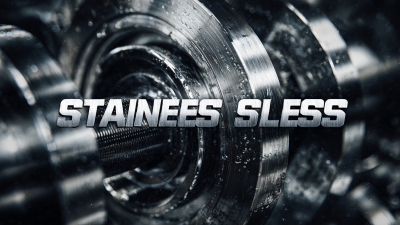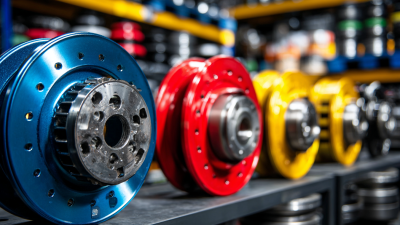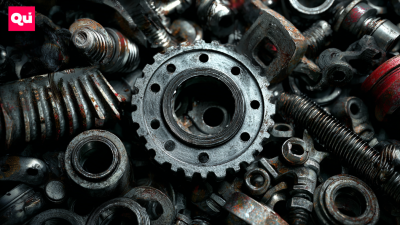Leave Your Message
-
Phone
-
E-mail
As the automotive industry continues to evolve, the exploration of materials that enhance performance and durability has become increasingly vital. One such material that has garnered significant attention is stainless steel, particularly in the context of automotive manufacturing. Stainless Steel Auto Parts are emerging as a game-changer in the quest for innovation, providing numerous advantages over traditional materials.

These parts not only offer exceptional resistance to corrosion, which enhances their longevity and reduces maintenance costs, but they also contribute to weight reduction and aesthetic appeal. As manufacturers strive to meet sustainability goals and consumer demands for higher quality and reliability, the incorporation of stainless steel into vehicle components promises to lead the charge towards the future of automotive innovation.
This discussion delves into the myriad benefits of stainless steel auto parts, highlighting their role in shaping the next generation of vehicles.
Stainless steel has emerged as a preferred material in the automotive industry, particularly for manufacturing components. One of its primary advantages lies in its excellent resistance to corrosion, which significantly enhances the durability and lifespan of auto parts. In environments exposed to varying weather conditions, stainless steel maintains its structural integrity, reducing the need for frequent replacements. This resilience translates to reduced maintenance costs over time, providing a practical solution for both manufacturers and consumers.
Additionally, stainless steel offers exceptional strength-to-weight ratios, making it an ideal choice for a wide range of automotive applications. This property allows for the design of lighter, yet stronger components that can contribute to improved fuel efficiency and performance. As automakers increasingly focus on sustainability and efficiency, stainless steel's recyclability further accentuates its role in the future of automotive innovation. By utilizing this material, manufacturers can create eco-friendly vehicles that meet the demands of an evolving market while maintaining high standards of safety and performance.
The automotive industry is increasingly turning towards sustainable materials, and stainless steel is emerging as a frontrunner in this transformation. One of the significant environmental benefits of utilizing stainless steel in auto parts production is its recyclability. Unlike many traditional materials, stainless steel can be recycled multiple times without losing its properties, significantly reducing the demand for raw materials and minimizing waste. This characteristic not only conserves energy during production but also lowers greenhouse gas emissions associated with obtaining and processing metal ores.
Moreover, stainless steel's durability and resistance to corrosion enhance the lifespan of auto parts, contributing to reduced environmental impact over time. Vehicles with stainless steel components require fewer replacements, leading to less frequent manufacturing cycles. This longevity translates to lower resource consumption and diminished environmental burden throughout the vehicle lifecycle. By integrating stainless steel into automotive design, manufacturers can not only meet the growing demand for eco-friendly practices but also pave the way for a more sustainable future in the automotive sector.
The automotive industry is increasingly turning to stainless steel components to enhance vehicle durability and safety. As of 2023, the global stainless steel market is valued at approximately $206.91 billion, with projections suggesting it will grow to $320.37 billion by 2032, reflecting an expanding demand across various sectors, including automotive. The utilization of stainless steel in auto parts, such as side steps and Nerf bars, offers increased resistance to corrosion and wear, thereby significantly extending the lifespan of vehicles.
Furthermore, specific niche markets within the automotive sector are also experiencing substantial growth. For instance, the electric vehicle battery box market is expected to surge from $253.31 million in 2024 to an astonishing $1.876 billion by 2032, highlighting the importance of durable materials like stainless steel in supporting the longevity and safety of electric vehicle components.
Additionally, the automotive control cable market is anticipated to rise from $5.24 billion in 2023 to $7.13 billion by 2032, driven by the demand for reliable and robust materials that ensure optimal performance. The integration of stainless steel into these applications underscores its critical role in reinforcing the safety and durability of modern vehicles.
Stainless steel has emerged as a game-changer in the automotive industry, offering a cost-effective alternative to traditional materials. Its durability and corrosion resistance significantly reduce maintenance costs and extend the lifespan of auto parts. By integrating stainless steel components into modern vehicles, manufacturers can minimize replacement frequency and associated labor costs. This not only benefits the consumers through long-term savings but also enhances the overall efficiency of production as manufacturers spend less time and resources on repairs or replacements.
Moreover, the versatility of stainless steel allows for innovative design solutions within automotive applications. With its lightweight properties, it contributes to improved fuel efficiency without compromising structural integrity. This dual benefit of cost-effectiveness and enhanced performance positions stainless steel as a key material for the future of automotive engineering. As the industry shifts towards sustainable practices, the use of stainless steel further aligns with environmental goals, promoting recycling and reducing the carbon footprint associated with traditional auto parts.

The adoption of stainless steel in the automotive industry is being significantly influenced by several innovative technologies. Advances in manufacturing processes, such as precision casting and additive manufacturing, have made it feasible to produce high-performance stainless steel components that meet the stringent requirements of modern vehicles. These technologies not only improve the accuracy and consistency of parts but also enable the creation of complex geometries that were previously challenging with traditional materials. This capability allows engineers to fully leverage the unique properties of stainless steel, such as its corrosion resistance and strength-to-weight ratio.

Additionally, the rise of sustainable manufacturing technologies has bolstered the case for stainless steel auto parts. The circular economy principles encourage the use of recyclable materials, and stainless steel excels in this regard. Innovative recycling processes are being developed, further minimizing waste and environmental impact. Furthermore, the integration of smart manufacturing systems, including IoT and AI, enhances the production efficiency and quality control of stainless steel components, ensuring that they not only meet regulatory standards but also satisfy consumer demands for durability and performance. These technological advancements are paving the way for a more sustainable and resilient automotive industry, where stainless steel plays a leading role.






